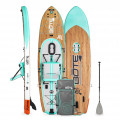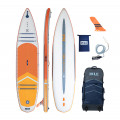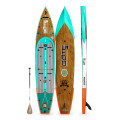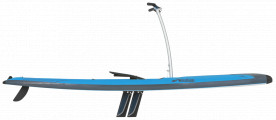If you’ve ever dreamed of walking on water, then a pedal paddleboard might be for you. A pedal paddleboard is a standup paddleboard with pedals that you propel with your legs and feet by making a stepping motion up and down. The pedals drive a fin system that moves the board forward.
Another key difference between a pedal drive paddleboard and a standard SUP (standup paddleboard) is the upright handlebar that is used for balance and steering. Rather than turning the handlebar, as on a bike, steering is accomplished by squeezing a lever on either side to control a rudder.
Paddleboards that you pedal were first introduced in 2016 and are still a relatively new recreational watercraft. They’re intended for use on calm, sheltered waters and offer a fun, unique experience for both beginners and longtime paddleboarders.
Andrew Finnegan, a sales representative for Swift Canoe & Kayak, says that pedal powered paddleboards are popular with seniors and others who want to enjoy standup paddleboarding but might not have strong balance, as well as those who simply prefer to pedal instead of paddle.
Pedal paddleboards are also commonly seen at resorts as rental options for exploring near-shore waters, and can even be used for paddleboard fishing with the option of a removable seat and space for a tackle box behind the pedals.
Pedal powered paddleboards offer a great leg and core workout and are a fun way to take your fitness routine, cross training or daily stroll out on the water. The motion is much like that of an elliptical machine. The speed of the board is controlled by the speed at which you pedal. You can cruise at a relaxed pace or increase the pedal rate to pick up speed. By moving the location of your feet on the pedals you can also increase or decrease the difficulty of pedaling to match the effort you want to exert.
If you want to shift from pedaling to paddling, the board can be easily converted into a standard SUP and used with a paddle. Simply remove the handlebars and pedal drive system and secure the pedals into the deck so that you can stand directly on the deck and paddle.
Removing the handlebar, pedal drive system and rudder also allows for easier transportation and storage of the pedal paddleboard. Once all components are removed, the board can be secured to the roof of a vehicle for transportation, just like a typical standup paddleboard. An inflatable pedal paddleboard offers even easier portability, deflating and packing into a rolling storage bag when not in use.
Currently, the only brand producing a standup paddleboard with foot pedals is Hobie, with three options to choose from: 10.5-foot and 12-foot hard boards made of durable composite epoxy, and an 11.5-foot inflatable, introduced in 2021. Better known for their Hobie Mirage pedal drive recreational, fishing and sailing kayaks, Hobie began as a surf brand in 1950 and brings decades of experience to their boards and pedal drives.
If you’re ready to try this fun new sport, this guide outlines everything you need to get started. If you prefer the feeling of pulling a paddle through the water, then head over to Best Touring Paddleboards and we’ll get you set in the right direction.
Top picks: Best pedal paddleboards for 2024
The following pedal paddleboards have received the highest star ratings by reviewers in our Paddling Buyer’s Guide. See and review all pedal paddleboards here.
Best Pedal Paddleboards

Rackham Aero 12'4"
Shop pedal paddleboards
Since there are not many standup paddleboards with pedals available on the market, the task of narrowing down which one is right for you becomes that much easier. Our Paddling Buyer’s Guide includes all the specs, prices and reviews if you’re ready to start shopping.
Shopping for a used pedal paddleboard?
The advanced technology and additional components of a standup paddleboard with foot pedals means that new pedal paddleboards cost substantially more than entry-level SUPs. Consider searching for a used board to make the purchase more affordable. Just keep in mind that these boards are only a few years old, so the used market is limited—finding a match will take patience and a bit of luck.
When shopping for a used standup paddleboard with pedals, the biggest consideration is the functionality and condition of the moving parts. Unlike classic standup paddleboards, a pedalboard has an advanced pedal and fin drive, as well as a handlebar and rudder steering system, that can become damaged or worn. Inspect and test all of these parts before making a purchase.
Inspect and test the pedal drive system
Check the split fins for any damage and ensure that they flex and then return to a straight position once the force on the fin is removed. Install the pedal drive system to ensure all of the parts fit together and then test that the fins move side to side when the pedals are pressed down. You may perform this test on the water or by turning the pedal paddleboard onto its side while on land.
Inspect and test the rudder
Ensure the rudder can move in both the vertical and horizontal directions and that there is no damage to the drive cables or to the connection point. Check that the rudder locks into place as well and is easily removed.
Inspect and test the pedals
Ensure that the pedals move freely up and down and that they lock down into place with the bungee cord.
Inspect and test the handlebar
Install and remove the handlebar to ensure that everything fits together as it should and locks into place properly. Ensure the height of the handlebar adjusts as required. Inspect the steering cable for any damage and squeeze each of the steering levers while the cable is connected to verify that the rudder responds by moving to the appropriate side.
Replacement parts are available from Hobie—for a price. Unless the used paddle pedalboard is heavily discounted, if it’s broken, don’t buy it.
Since inflatable pedal paddleboards are new to the market in 2021, it may take some time before we start to see these available to purchase used. In addition to the above inspections, it’s important to blow up an inflatable board to confirm that there are no leaks and to inspect the seams around the deck pad, where the pedal drive system inserts, to ensure there is no wear from the pedal movement against the materials.
For more tips on what to look for when selecting a used paddleboard, read our article How To Buy A Used Paddleboard.
Pedal paddleboard buying guide
Shopping for a pedal paddleboard is fairly straightforward, as there are only a handful of designs to choose from. However, there are still a few key decisions to make, such as board size, whether you want an inflatable or a hard board, the weight of the board, how you will transport it and the maximum weight capacity of the board.
Let’s cover each one here:
Size of the pedal paddleboard
The size of the board correlates, in part, to the size of the user. Choose a longer board (12 feet) for larger users, while smaller users will find a shorter board (10.5 feet) easier to maneuver. Length also affects overall speed, and in general, a longer board will be slightly faster.
Inflatable vs hard board
The main advantage of an inflatable board is portability. Hobie’s 11-foot inflatable pedalboard packs into a compact rolling duffel for unmatched ease of transportation and storage. The inflatable pedal paddleboard is also significantly lighter—28 pounds compared to 48 pounds for the hard board.
On the other hand, hard boards require less maintenance and do not require as much setup to use—just install the handlebar and pedal drive system and you’re ready to go.
Weight of the pedal paddleboard
The weight of the pedal paddleboard matters most when it comes to moving and transporting the board. When comparing specs, you’ll find both a hull weight and a fully rigged weight. The hull weight is the weight of the pedal paddleboard without the handlebar, pedal drive system or rudder installed—in other words, this is the weight of the board when you’ll be lifting or transporting it.
This ranges from 28 lbs for the inflatable up to 48 lbs for the 12-foot hard board. The fully rigged weight is the weight of the pedal paddleboard with all components required for use installed.
Transportation of the pedal paddleboard
The inflatable pedal paddleboard can be easily transported in a rolling travel bag. The hard board can be carried and secured to a roof rack like a standup paddleboard once the handlebar and pedal drive system are removed.
An alternative to carrying the boards is Hobie’s lightweight cart system, which secures to the bottom of the board and allows users to easily transport the fully rigged board across sand, gravel or grass.
Maximum weight capacity of the pedal paddleboard
It is important to select a pedal paddleboard which has a weight capacity that exceeds that of the user. For the hard boards, the 10.5-foot board has a weight capacity of 225 lbs, while the 12-foot board holds up to 275 lbs. The 11-foot inflatable pedal paddleboard has the largest weight capacity, at 300 lbs.
Still have questions? Here are answers to some of the most common questions about standing paddleboards with pedals.
-
What is a pedal paddleboard?
A pedal paddleboard is a variation of a standup paddleboard which uses a pedal drive system, powered by the user’s feet stepping up and down, to propel the board forward by moving two underwater fins. Imagine a paddleboard which has handlebars like a bicycle as well as pedals in the middle of the board which move up and down similar to an elliptical machine. The handlebars have levers which control a rudder to steer the board.
A pedal paddleboard is very easy and intuitive to use and is great for general fitness and for those who have poor balance or simply want more stability when standup paddleboarding. Pedal paddleboards range in length from 10.5 feet to 12 feet long, with hard board and inflatable options, and can be used by both beginners and experienced paddlers to enjoy sheltered waters.
-
What is pedalboarding?
Pedalboarding is a fun and beginner-friendly water sport that is an evolution of standup paddleboarding. Instead of using a paddle, riders use a pedal drive system to propel the board. Pedalboarding was first introduced in 2016 and looks very similar to walking on water, as users propel an underwater fin system by stepping up and down on pedals built into the board’s deck to generate forward motion. Steering is controlled by squeezing a lever on a handlebar, just like using a brake on a bicycle.
Pedalboarding is commonly offered as an on-water activity at resorts and rental properties as no prior experience is required. Pedalboarding is a good option for those who would rather pedal than paddle or who might have upper body limitations. It also suits older users who want a gentle form of fitness on the water, or those who struggle with balance on a traditional standup paddleboard.
-
Pedal board vs paddleboard
Pedal boards are an evolution of a paddleboard where users power the watercraft by stepping on a pedal drive system, rather than using a paddle. Pedal boards are more beginner friendly than paddleboards, as they are generally wider and more stable, the user is not required to learn various paddle strokes, and steering the pedal board is very easy and done by squeezing levers on a handlebar. The handlebar also assists with balance while standing, making pedal boards accessible to entry-level paddlers and those who find balancing on a traditional standup paddleboard difficult.
Paddleboards typically come ready to hit the water, whereas pedal boards require some installation of moving parts prior to use, including the rudder, handlebar and pedal drive system. These components of the pedal board may also be uninstalled to convert the pedal board into a conventional paddleboard.
Pedal boards have a displacement-style hull, like the bottom of a sailboat or a touring style of paddleboard, with a sharp nose and V-shaped bottom to cut through waves and chop for a smoother and more efficient ride. They are best suited to fitness and general recreational use on sheltered waters. By comparison, standup paddleboard designs are more varied with a wide range of shapes and styles suited to touring, surfing, camping trips, SUP yoga and even whitewater paddling.
Standup paddleboards with pedals are expensive compared to traditional standup paddleboards. Pedal boards also have limited availability, as there aren’t many options available on the market.
In terms of the user experience, a pedal board is easy and intuitive to use but doesn’t have much of a skill development component. On a standup paddleboard a paddler has the ability to perform and master many different strokes and techniques to brake, reverse, move the board sideways, pivot turn and more.
Pedal boards do offer some advantages to standup paddleboards, however. They have better stability through chop and waves, along with quick, easy steering. Pedal boards are also easier to use in a headwind and current, and you won’t be stuck paddling on one side if the wind or waves are at your side. The pedal drive fins also move more water than a paddle stroke, making it easy and efficient to cover more distance.
If you are deciding between a pedal board and a standup paddleboard, keep these pros and cons in mind:
Pedalboard pros
- Good stability
- Beginner friendly
- Easy and intuitive to use and steer
- Handles adjust to the required height of the user
- Efficient in wind, waves, current
- Won’t be stuck paddling on one side
- Less likely to fall off of but can tip over
- Rudders and fins kick up in shallow water
- Converts to a paddleboard
Pedalboard cons
- Heavy
- Expensive
- Requires some installation of parts for use
- May need a pull cart for transportation
- Mostly lower body workout
Standup paddleboard pros
- Lighter
- More variety in price range to suit budget
- More options for board designs based on the primary use of the board
- More control over the board with braking, reverse, moving the board sideways
- Easier to transport
- More of an upper and full body workout
Standup paddleboard cons
- Requires more skill and knowledge for paddling technique
- Less efficient in wind, waves, current
- No handlebar to hold onto for balance
- Fins do not kick up in shallow water
-
How do pedal powered standup paddleboards work?
A pedal powered standup paddleboard works by the user stepping up and down on pedals in the deck to move a split fin system underwater, propelling the board through the water. The speed of a pedal paddleboard is controlled by the speed of the user stepping up and down on the pedal drive system. The steering is controlled through squeezing a lever on a handlebar, similar to a bicycle, which directs a rudder at the back of the pedal paddleboard.
-
Pedal paddleboard price
Pedal paddleboards are an investment that will put a bit of a dent in your wallet, at double to triple the price of entry-level standup paddleboards. A 12-foot pedal paddleboard costs $2,799 USD, while an inflatable model is only slightly cheaper at $2,549 USD. These prices are comparable to some composite racing standup paddleboards. The silver lining: you’ll save the price of a paddle.
Pedal paddleboard reviews
If you’re still pondering on whether or not a pedal paddleboard is the right choice for you, or are just curious about what pedal paddleboard users have to say, take a look at the reviews below from those who’ve walked on water.
- Inflatable SUP Review: BOTE Rackham Aero 12’4”
- Hybrid SUP Kayak Review: Hobie Mirage Lynx
- Hybrid Fishing SUP Review: Vibe Cubera 120
- Hobie Mirage Eclipse SUP Board (Video)








